Education
Warbler Identification “Quick Finders”
Warblers are among the most challenging birds to identify, with their seasonally changing plumage and often-confused songs and calls. Eight illustrated plates are available for free download, provided by the authors of The Warbler Guide. Use these "Quick Finders" to help you identify any of the 56 species of warblers in the United States and Canada.
Included in the → PDF Download:
Warbler faces, Side views, 45° views, Undertail views, Warblers by region, Spring/fall warblers. Thanks to Cornell University researchers Maren Vitousek, Conor Taff and Monique Pipkin.
Bird Sounds Of Southeast Arizona/Sonora
Makes an excellent addition to the audio library of intermediate to advanced birders who wish to boost their knowledge of and expertise with rare and local birds specific to the Arizona borderlands and northern Sonora.
About one quarter of the audio files are Diane Doyle’s own recordings and the remaining are sourced from Xeno-Canto. This digital 117-track, 75 species, 5 disc collection is available as a free download. The audio files can be loaded on a smartphone, tablet, laptop or desktop computer. Since the audio files are edited, each “disc” is only the size of a few high res photos.
Visit https://www.aba.org/seaz-tracks/ to download the available tracks.— American Birding Association
Live Bird Migration Maps
Real-time analysis maps show intensities of actual nocturnal bird migration as detected by the US weather surveillance radar network between local sunset to sunrise. There is a yellow line moving east to west representing the timing of local sunset. Areas with lighter colors experienced more intense bird migration. Orange arrows show directions to which birds flew.
Cornell Lab of Ornithology currently produces these maps. Support for this research came from NASA, Edward W. Rose Postdoctoral Fellowship, and Amazon Web Services. The BirdCast project was created by grants from the National Science Foundation and supported by additional grants from Leon Levy Foundation.
Help Us Introduce Youngsters to Birdwatching
 We had our first classroom activity with Ms Yvette Troy's 3rd graders at José Barrios, and have outdoor activities planned for the spring. We hope to expand activities with other elementary school children; stay tuned! We’ll be needing binoculars for this project and would appreciate donations of any binoculars you no longer use.
We had our first classroom activity with Ms Yvette Troy's 3rd graders at José Barrios, and have outdoor activities planned for the spring. We hope to expand activities with other elementary school children; stay tuned! We’ll be needing binoculars for this project and would appreciate donations of any binoculars you no longer use.
Have extra binoculars to donate? You may bring them to any Audubon program, see Programs for dates →
Collaborative Grant Awarded to SWNMA
We are pleased to be the recipient of $1000 from the Audubon Collaborative Grant program. We purchased six additional pairs of binoculars to share in classrooms and on field trips, and will develop and purchase durable education materials for classroom programs to increase activities already started at José Barrios Elementary School.
It's Bird Time at School!
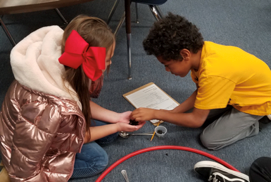 Board member Lisa Fields has had a great time with two lessons about birds in Ms Yvette-Torrez Troy’s third grade class at José Barrios Elementary School. The first lesson focused on types of beaks and the relationship to what birds eat. The students played a game, “Bon AppeTweet,” and collected data about which food types their “beaks” were best and worst suited to be able to eat.
Board member Lisa Fields has had a great time with two lessons about birds in Ms Yvette-Torrez Troy’s third grade class at José Barrios Elementary School. The first lesson focused on types of beaks and the relationship to what birds eat. The students played a game, “Bon AppeTweet,” and collected data about which food types their “beaks” were best and worst suited to be able to eat.
The second lesson was about feathers, type, form and function as well as feather anatomy. The students used hand-held magnifiers to examine how the feather vanes’ barbules “zip” together. Both sessions included short, on-line videos. The class also made pine cone bird feeders to hang up at home, and several of the students have been observing their backyard birds!
Bird-window Collisions (BWCs)
The Largest Human-Caused Bird Mortalities, it is estimated that in the United States alone nearly a billion birds are killed annually from BWCs. (e.g. a bird will mistake the reflection of a tree for the actual tree.) While the birds are spending time attacking their reflection in the window glass they are not out gathering food or raising their young. Here are a few different ways you can help avoid these window collisions, by David Sibley, ornithologist, author and illustrator;
The “Fluorescent grid” method
- Clean the inside of window.
- Use a fluorescent yellow hi-lighter.
- Draw lines on inside glass 2" vertically, and 4" horizontally. This can be done freehand or with a straight edge for a guide. Re-apply every couple of weeks when the fluorescent fades. Ed. note: Go artistic!
Sibley also has had success using monofilament line. “Continuing my own experiments I’ve had over a month of 100 percent success with an array of monofilament stretched between two wooden boards outside the window. The monofilament is suspended a couple of inches in front of the window in vertical lines about three inches apart. It is very inconspicuous from inside, and has worked perfectly under some very busy conditions.”
Alex Sally recommends using a pen for ‘writing on glass.’ It washes, but can get scraped off. Draw 4" vertical lines. with straight edge as a guide, or freehand. birdsavers.com
Bird Crash Preventer is a ready-to-hang "curtain" of fine nylon monofilament lines. Brackets and screws included for self installation. Available from birdsavers.com
Bird’s Eye View Decals can help reduce birdstrikes by making the glass more visible to our feathered friends. The unique geometric lenses refract UV light and have proven highly effective in reducing bird window collisions. It is recommended to place (2) 6" pieces or (4) 4" pieces in the center of the window about 4” apart. Place on the inside of the glass. There is no absolute as to the number of pieces required since each condition will vary but this is a good starting point. The film will fluoresce and be effective beyond the surface area of the film. abcbirds.org/get-involved/bird-smart-glass
Also from abcbirds, “Acopian” method uses lengths of parachute cord hanging every 4” from top of window. Can tie a knot at the end and let it dangle.
Feather Friendly® DIY, these adhesive dots applied to the outside of your windows create an effective “frit” pattern. The dots should be 4" horizontally and 2" vertically.

ACTIVITY GUIDES FOR KIDS - CONSERVATION & BIRD BOOKLETS
By 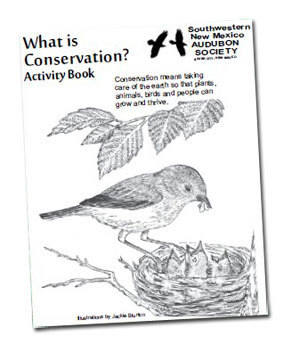 Jackie Blurton
Jackie Blurton
This SWNM Audubon activity book for kids is understandable to young children, inexpensive, and easy to produce in small quantities - single fold booklets that can be printed on 8.5 x 14 copy paper in any quantity needed. The first booklet was inspired by our Chapters gift of the Audubon Bird House Book by Barker & Wolfson to libraries in our area and by the Silva Creek Botanical Garden that the Gila Native Plant Society is creating in Silver City.
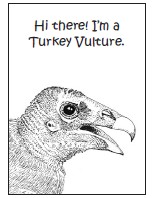 A Tale of 4 Birds: Activity Book (→ PDF)
A Tale of 4 Birds: Activity Book (→ PDF)
Our second book for kids is about birds. There are many different kinds of birds. To help us identify birds with similar characteristics, they are grouped into families. Here are three families of birds that share characteristics. Knowing these similarities will help you identify the bird.
Birds prefer different plants just
 like you and I like different foods. Birds and plants can help each other. Here are three birds that have beneficial relationships with the plants that provide them with food. The book has four activities about birds and the food they eat.
like you and I like different foods. Birds and plants can help each other. Here are three birds that have beneficial relationships with the plants that provide them with food. The book has four activities about birds and the food they eat.Our Swallow Friends (→ PDF)
Swallows are common residents in the summer. They live together in groups called “colonies” and build their mud homes in cliffs, under bridges and under the eaves of buildings. They often fly together in flocks while they hunt for insects that they capture in mid-air.
Swallows have sleek, streamlined bodies and long narrow wings which allow them to turn quickly to catch insects. Different species look similar in shape but have distinct color patterns that make them different from each other. The Cliff, Barn, Violet-green and Northern rough-winged swallows live here all summer to nest and raise their families. The Tree swallow and Bank swallow migrate through here on their journey north.
POCKET-SIZE CHECKLIST OF BIRDS
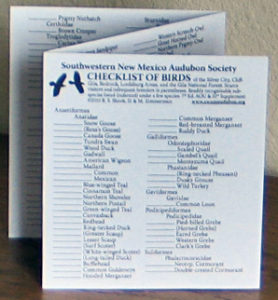 The Southwestern New Mexico Audubon publication Checklist of Birds, by R. Shook and D. & M. Zimmerman, follows the latest AOU and 51st Supplement order of listings.
The Southwestern New Mexico Audubon publication Checklist of Birds, by R. Shook and D. & M. Zimmerman, follows the latest AOU and 51st Supplement order of listings.
Covering the area of Silver City, Cliff-Gila, Redrock, Lordsburg and the Gila National Forest, the 3-fold card identifies visiting and infrequent breeding birds and notes readily recognizable sub-species. There is space to record date and/or number of birds seen, and small enough (3 ¾ by 4 ¼) to fit in your pocket. Checklists are 50 cents each, or 5 for $2 and for purchase at SWNM programs.
HOW TO BRING CONSERVATION TO YOUR BACKYARD
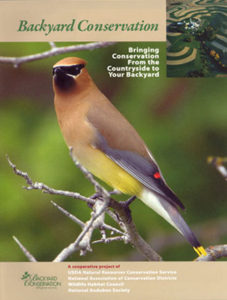 National Audubon, Natural Resources Conservation Service, and other conservation groups, along with the National Resource Conservation Service have co-produced a beautiful 28-page color booklet named "Backyard Conservation" showing you how farm and ranch conservation practices can be adapted for use in any size front yard or back yard. Some Conservation practices highlighted are mulching, composting, terracing, nutrient management, pest management, tree planting, ponds, wetlands, wildlife habitat, terracing and water conservation. The FREE booklet is available in English or Spanish as a service provided by Southwestern New Mexico Audubon. Pick one up at the next chapter program meeting, first Friday of each month.
National Audubon, Natural Resources Conservation Service, and other conservation groups, along with the National Resource Conservation Service have co-produced a beautiful 28-page color booklet named "Backyard Conservation" showing you how farm and ranch conservation practices can be adapted for use in any size front yard or back yard. Some Conservation practices highlighted are mulching, composting, terracing, nutrient management, pest management, tree planting, ponds, wetlands, wildlife habitat, terracing and water conservation. The FREE booklet is available in English or Spanish as a service provided by Southwestern New Mexico Audubon. Pick one up at the next chapter program meeting, first Friday of each month.CATS INDOORS
 serious consequences.
serious consequences.
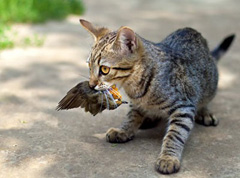 Cats have been introduced into new habitats across the globe with terrible results. Outdoors, cats are a non-native and invasive species that threaten birds and other wildlife, disrupt ecosystems, and spread diseases.
Cats have been introduced into new habitats across the globe with terrible results. Outdoors, cats are a non-native and invasive species that threaten birds and other wildlife, disrupt ecosystems, and spread diseases.
Now numbering well over 100 million in the United States, cats kill approximately 2.4 billion birds every year in the U.S. alone, making cat predation by far the largest human-caused mortality threat to birds.
The American Bird Conservancy Cats Indoors Program educates the public and policy makers about the many benefits to birds, cats, and people when cats are maintained indoors or under an owner's direct control. In addition to advocating for responsible pet ownership, we also oppose Trap, Neuter, Release (TNR) for feral cats because of the persistent and severe threats posed by feral cat colonies. SWNM Audubon, New Mexico Audubon Council, and The American Bird Conservancy jointly produced this brochure for keeping cats indoors. [ Cats Indoors PDF ]
SILVER CITY GREENWAYS BROCHURE MAP
Big Ditch Park, San Vicente Creek, Boston Hill, La Capilla Wetlands (PDF). Get one at Audubon Programs or at the Visitors Center, 201 N Hudson, Silver City, NM.
- American Bird Conservancy
- Audubon Bird Guide App
- Audubon Guide to Bird ID
- Audubon New Mexico
- Audubon en Español
- NatureInstruct Dendroica
- Xeno-Canto global birdsong
- American Birding Association
- Gila National Forest
- Cornell FeederWatch
- BirdSource
- EBird.org
- TripBuzz.com Birdwatching Guide
- HomeAdvisor.com Birdwatching Guide
- Guide to Birding From Our Window
- TreeMusketeers.net/birdwatching-guide/
You Need A Permit!!





